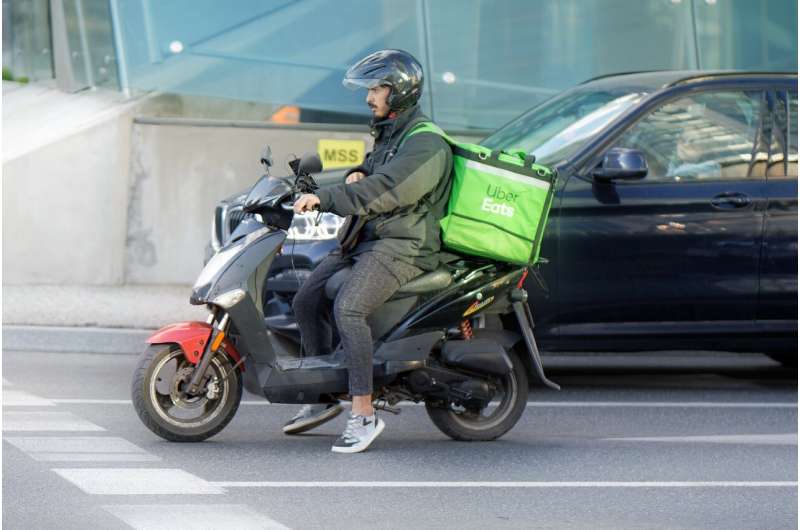
Image credit: Pixabay/CC0 Public Domain
Social status – defined by household income and professional role – is linked to food delivery preferences in England, according to an analysis of consumer surveys published in the open access journal BMJ Public Health.
Affluent households are twice as likely to shop for groceries online as less affluent ones, while households in lower social classes are up to twice as likely to use takeaway food delivery apps. And users of these apps are more likely to suffer from obesity, the results show.
Digital on-demand technology has rapidly and dramatically changed food distribution and delivery, making it easier and more convenient to purchase groceries and ready meals to take away and increasing the range of options available, the researchers note.
However, previous research suggests that while online grocery shopping is associated with healthier food choices, using online takeaway food delivery apps is less so, prompting researchers to examine the impact of ongoing changes in the food retail industry.
In particular, they wanted to investigate the extent to which the use of online food delivery services is influenced by indicators of social status – income and occupational role – and whether the use of these services is associated with healthy or unhealthy weight.
They drew on data from a large consumer panel previously used in the Transport for London study, which examined the impact of stopping advertising for foods high in fat, salt and sugar on the Transport for London network.
This included analysis of food and drink shopping records and a survey of a representative sample of 1,521 households in London and the North of England on their daily food and drink shopping method and their self-reported use of food delivery apps for ready-to-go meals in February 2019.
Social status was characterized by both household income and the social status of the household’s main shopper and classified as follows: high, medium-high, medium-low and low.
Self-reported annual household income was measured in three ranges: £0–£19,999, £20,000–£49,999 and £50,000 or more.
Data on body mass index (BMI) were available for 1,245 (82%) households and were categorized into combined underweight and normal weight under 25, overweight between 25 and 29.9, and obesity over 30.
An analysis of purchase records found that in February 2019, nearly 16 percent of households purchased groceries online at least once. Survey responses revealed that 13 percent had used takeaway food delivery apps in the past seven days and 3.5 percent said they had used both services.
After accounting for potentially influential household factors such as age and composition of residents, households with the highest incomes were twice as likely to buy groceries online as those with the lowest incomes. However, there was no association with social class.
And although food delivery app use was not related to income, it was linked to social class after controlling for potentially influential factors such as age, gender and educational attainment.
Those in the lowest social class were more than twice as likely to use these apps as those in the highest social class; those in the middle to lower social class were 69 percent more likely to do so.
There were no associations between weight and online grocery shopping, but those who used food delivery apps were 84% more likely to be obese and 45% more likely to be overweight than those who did not use them. Similar results were obtained after adjusting for social class and household income.
This is an observational study, so no firm conclusions about cause and effect can be drawn. And the researchers acknowledge that survey responses reflect a specific point in time and are based on recall.
The analyses are also limited by the uneven distribution of households across different social classes and income groups. In addition, the sample of predominantly urban households in London and northern England may not be entirely representative of the country as a whole, they say.
However, they say: “Our findings suggest that there are differences in usage, both within and between the online grocery and online takeaway sectors.”
Although they did not closely examine the contents of food and meals ordered online or via app, previously published research suggests that use of food delivery apps is associated with lower diet quality and that online grocery shopping tends to have higher diet quality than in-store shopping, the researchers point out.
“In the grocery sector, it has been hypothesized that affluent households will be more likely to shift to online grocery shopping, and it is possible that we have observed evidence of this,” they write.
“It is possible that grocery shopping depends primarily on financial resources, while buying take-away food is related to culture and social group,” they suggest.
They say digital food delivery apps may also make it easier to choose unhealthy foods. They add: “Different uses of online food delivery services may exacerbate dietary inequalities and require further research.”
Further information:
Social inequalities in the use of online food delivery services and associations with weight status: cross-sectional analysis of survey and consumer data, BMJ Public Health (2024). DOI: 10.1136/bmjph-2023-000487
Provided by the British Medical Journal
Quote: Social position linked to food delivery preferences in England (20 August 2024), accessed 20 August 2024 from https://medicalxpress.com/news/2024-08-social-position-linked-food-delivery.html
This document is subject to copyright. Except for the purposes of private study or research, no part of it may be reproduced without written permission. The contents are for information purposes only.

